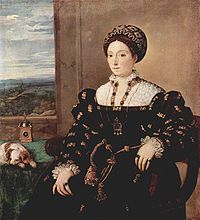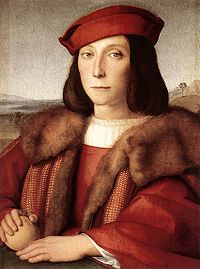
Francesco Maria I della Rovere
Encyclopedia



Italy
Italy , officially the Italian Republic languages]] under the European Charter for Regional or Minority Languages. In each of these, Italy's official name is as follows:;;;;;;;;), is a unitary parliamentary republic in South-Central Europe. To the north it borders France, Switzerland, Austria and...
condottiero, who was Duke of Urbino from 1508 until 1538.
Biography
He was born in SenigalliaSenigallia
Senigallia is a comune and port town on Italy's Adriatic coast, 25 km by rail north of Ancona, in the Marche region, province of Ancona....
, the son of the Papal captain and lord of that city, Giovanni della Rovere
Giovanni della Rovere
Giovanni della Rovere was an Italian condottiero and member of the Della Rovere family. He was a nephew of Pope Sixtus IV, and the brother of Giuliano della Rovere , elected to the papal throne as Pope Julius II in 1503....
, and of Giovanna da Montefeltro, daughter of Federico III da Montefeltro. He was also the nephew of Giuliano della Rovere, pope as Julius II from 1503.
His uncle Guidobaldo I of Urbino
Guidobaldo da Montefeltro
thumb|240px|Portrait of Guidobaldo da Montefeltro by [[Raphael]].Guidobaldo da Montefeltro , also known as Guidobaldo I, was an Italian condottiero and the Duke of Urbino from 1482 to 1508.-Biography:...
, who was heirless, called him at his court, and named him as heir of that dukedom in 1504 through the intercession of Julius II. In 1502 the della Rovere had lost the seigniory of Senigallia, occupied by Cesare Borgia
Cesare Borgia
Cesare Borgia , Duke of Valentinois, was an Italian condottiero, nobleman, politician, and cardinal. He was the son of Pope Alexander VI and his long-term mistress Vannozza dei Cattanei. He was the brother of Lucrezia Borgia; Giovanni Borgia , Duke of Gandia; and Gioffre Borgia , Prince of Squillace...
, then the most powerful figure in the Marche
Marche
The population density in the region is below the national average. In 2008, it was 161.5 inhabitants per km2, compared to the national figure of 198.8. It is highest in the province of Ancona , and lowest in the province of Macerata...
: Francesco Maria and his mother were saved from the slaughter perpetrated by Borgia's troops by the then-land soldier Andrea Doria
Andrea Doria
Andrea Doria was an Italian condottiere and admiral from Genoa.-Early life:Doria was born at Oneglia from the ancient Genoese family, the Doria di Oneglia branch of the old Doria, de Oria or de Auria family. His parents were related: Ceva Doria, co-lord of Oneglia, and Caracosa Doria, of the...
. When in 1508 Guidobaldo died, Francesco Maria became duke of Urbino; thanks to the support of his uncle Giuliano della Rovere, now pope as Julius II, he could also recover Senigallia after Borgia's death.
In 1508 he married Eleonora Gonzaga
Eleonor Gonzaga (1493–1570)
Eleonora Gonzaga, Duchess of Urbino was the eldest of the seven children of Francesco II Gonzaga, Marquess of Mantua, and Isabella d'Este. Her father was a notorious libertine, and her mother, a gifted patroness of the arts of the late Italian Renaissance...
(1493-1570), daughter of Francesco II Gonzaga, Marquess of Mantua
Francesco II Gonzaga, Marquess of Mantua
Francesco II Gonzaga was the ruler of the Italian city of Mantua from 1484 until his death.-Biography:Gonzaga was born in Mantua, the son of Marquess Federico I Gonzaga. He had a career as a condottiero acting as Venice's commander from 1489 to 1498...
and Isabella d'Este
Isabella d'Este
Isabella d'Este was Marchesa of Mantua and one of the leading women of the Italian Renaissance as a major cultural and political figure. She was a patron of the arts as well as a leader of fashion, whose innovative style of dressing was copied by women throughout Italy and at the French court...
.
In 1509 he was appointed as (commander-in-chief) of the Papal States
Papal States
The Papal State, State of the Church, or Pontifical States were among the major historical states of Italy from roughly the 6th century until the Italian peninsula was unified in 1861 by the Kingdom of Piedmont-Sardinia .The Papal States comprised territories under...
, and subsequently fought in the Italian Wars
Italian Wars
The Italian Wars, often referred to as the Great Italian Wars or the Great Wars of Italy and sometimes as the Habsburg–Valois Wars, were a series of conflicts from 1494 to 1559 that involved, at various times, most of the city-states of Italy, the Papal States, most of the major states of Western...
against Ferrara
Ferrara
Ferrara is a city and comune in Emilia-Romagna, northern Italy, capital city of the Province of Ferrara. It is situated 50 km north-northeast of Bologna, on the Po di Volano, a branch channel of the main stream of the Po River, located 5 km north...
and Venice
Venice
Venice is a city in northern Italy which is renowned for the beauty of its setting, its architecture and its artworks. It is the capital of the Veneto region...
. In 1511, after he had failed to conquer Bologna
Bologna
Bologna is the capital city of Emilia-Romagna, in the Po Valley of Northern Italy. The city lies between the Po River and the Apennine Mountains, more specifically, between the Reno River and the Savena River. Bologna is a lively and cosmopolitan Italian college city, with spectacular history,...
, he had the cardinal Francesco Alidosi killed by his troops, a cruel action for which he was compared to Borgia himself. In 1513 he was created also lord of Pesaro
Pesaro
Pesaro is a town and comune in the Italian region of the Marche, capital of the Pesaro e Urbino province, on the Adriatic. According to the 2007 census, its population was 92,206....
.
However, the death of Julius II deprived him of his main political patron, and under the new pope, Leo X Medici, Pesaro was given to the latter's nephew, Lorenzo II de' Medici. In 1516 he was excommunicated and ousted from Urbino, which he tried unsuccessfully to recover the following year (see War of Urbino
War of Urbino
The War of Urbino was a secondary episode of the Italian Wars.The conflict ensued after the end of the War of the League of Cambrai , when Francesco Maria I della Rovere decided to take advantage of the situation to recover the Duchy of Urbino, from which he had been ousted in the previous year.In...
). He could return in his duchy only after Leo's death (1521).
Della Rovere fought as of the Republic of Venice
Republic of Venice
The Republic of Venice or Venetian Republic was a state originating from the city of Venice in Northeastern Italy. It existed for over a millennium, from the late 7th century until 1797. It was formally known as the Most Serene Republic of Venice and is often referred to as La Serenissima, in...
in Lombardy
Lombardy
Lombardy is one of the 20 regions of Italy. The capital is Milan. One-sixth of Italy's population lives in Lombardy and about one fifth of Italy's GDP is produced in this region, making it the most populous and richest region in the country and one of the richest in the whole of Europe...
during the Italian Wars of 1521 (1523–1525), but with the new Medici Pope, Clement VII, the della Rovere were increasingly marginalized. As supreme commander of the Holy League, his inaction against the Imperial invasion troops is generally listed as one of the causes of the Sack of Rome
Sack of Rome (1527)
The Sack of Rome on 6 May 1527 was a military event carried out by the mutinous troops of Charles V, Holy Roman Emperor in Rome, then part of the Papal States...
(1527).
He was a protagonist of the capture of Pavia
Pavia
Pavia , the ancient Ticinum, is a town and comune of south-western Lombardy, northern Italy, 35 km south of Milan on the lower Ticino river near its confluence with the Po. It is the capital of the province of Pavia. It has a population of c. 71,000...
in the late 1520s, and later fought for the Republic of Venice
Republic of Venice
The Republic of Venice or Venetian Republic was a state originating from the city of Venice in Northeastern Italy. It existed for over a millennium, from the late 7th century until 1797. It was formally known as the Most Serene Republic of Venice and is often referred to as La Serenissima, in...
. Later he arranged the marriage of son Guidobaldo
Guidobaldo II della Rovere
Guidobaldo II della Rovere was an Italian condottiero, who was Duke of Urbino from 1538 until his death.- Biography :...
to Giulia da Varano
Da Varano
The Da Varano was an Italian noble family who had an important role in the medieval and Renaissance history of central Italy, as rulers of Camerino and other lands in the Marche and Umbria.- Overview :...
(belonging to another former seigniory family of the region) to counter the Papal power in the Marche
Marche
The population density in the region is below the national average. In 2008, it was 161.5 inhabitants per km2, compared to the national figure of 198.8. It is highest in the province of Ancona , and lowest in the province of Macerata...
.
He died in Pesaro, poisoned. Some scholars suggest that The Murder of Gonzago, an unknown play referenced in William Shakespeare's
William Shakespeare
William Shakespeare was an English poet and playwright, widely regarded as the greatest writer in the English language and the world's pre-eminent dramatist. He is often called England's national poet and the "Bard of Avon"...
Hamlet, Prince of Denmark, which is itself later reworked by Hamlet into The Mousetrap (the play within the play), may have been a popular theatrical reenactment of Della Rovere's death and may have been portrayed in England's early theaters during the Elizabethan Era
Elizabethan era
The Elizabethan era was the epoch in English history of Queen Elizabeth I's reign . Historians often depict it as the golden age in English history...
.
Issue
- Giulia della Rovere (died 1563) married Alfonso d'Este, Lord of MontecchioAlfonso d'Este, Lord of MontecchioAlfonso d'Este was an Italian nobleman. He was the illegitimate son of Alfonso I d'Este, Duke of Ferrara by his lover Laura Dianti...
and had issue (were parents of Cesare d'Este, Duke of Modena); - Elisabetta della Rovere (died 6 June 1561) married Alberico Cybo, Prince of Massa and Carrara and had issue (ancestors of Maria Teresa Cybo-MalaspinaMaria Teresa Cybo-MalaspinaMaria Teresa Cybo-Malaspina was the Duchess of Massa and the Princess of Carrara from 1731 until her death in 1790. She was the eldest child of her parents, Alderano I Cybo-Malaspina and his wife Ricciarda Gonzaga...
); - Guidobaldo della RovereGuidobaldo II della RovereGuidobaldo II della Rovere was an Italian condottiero, who was Duke of Urbino from 1538 until his death.- Biography :...
(2 April 1514 - 28 September 1574) married Giulia Varano and had issue; married Vittoria Farnese (daughter of Pier Luigi Farnese, Duke of ParmaPier Luigi Farnese, Duke of ParmaPier Luigi Farnese was the first Duke of Parma, Piacenza and Castro, from 1545 to 1547.Born in Rome, Pier Luigi was the illegitimate son of Cardinal Alessandro Farnese...
) had issue (ancestors of Maria Teresa Cybo-Malaspina); - Giulio della RovereGiulio della RovereGiulio della Rovere, also known as Giulio Feltrio della Rovere was an Italian Catholic Cardinal of the della Rovere family....
(1533 - 1578) became a cardinal then later had issue (illegitimate); Ippolito and Giulio. - Ippolita della Rovere (b.1525) had issue.

